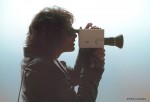Jim Morrison and Ray Manzarek are best known as the founding band members of The Doors. But many do not know that their friendship dates back to their time as UCLA film students.
Between 1963 and 1965, the pair contributed to five student films that are now held in the UCLA Film & Television Archive. The archive, with The Jim Morrison & Ray Manzarek Preservation Project, is campaigning to restore these films using crowdfunded donations in an effort to make them available to the public online or in the Billy Wilder Theater at the Hammer Museum.
“The Doors were a very iconic musical group, and I think a lot of people don’t realize they met at UCLA in film school,” said Randy Yantek, the archive’s digital lab manager. “Before the first music was ever made by these people, they made these films.”
The archive initiated the project as a way to honor UCLA’s centennial, said the archive’s director, Jan-Christopher Horak. The films will be part of an end-of-the-year program meant to highlight the works of well-known graduates – including members of The Doors, Horak said. After restoring the films, the archive plans to screen them in late 2019 or early 2020. Yantek said the restoration process can be challenging, depending on the condition of a film, but still rewarding.
“Once you’ve brought a film back to its original luster, or as close to it as you can, it’s rewarding,” Yantek said. “It’s impressive to see something … how it was intended to be seen.”
[RELATED: Weekend-long film festival features preservation of classic Hollywood films]
Manzarek directed two of the five films while at UCLA and played a supporting role in a third. Morrison, on the other hand, worked as a cameraman and sound technician on the remaining two. The archive’s priority restoration projects are “Evergreen,” directed by Manzarek, and “Five Situations for Camera, Recorder and People,” which Morrison worked as a sound technician on. If the archive’s goal of raising $65,000 is exceeded, it will work on restoring one of the remaining three films as well. Horak said the process to restore the 16 mm prints of the black and white films will involve cleaning them up, digitalizing them and most likely placing the film’s content on 35 mm film, which can last up to 500 years in a controlled environment.
“Evergreen” portrays a jazz musician struggling to agree to a long-term relationship with an art student. It shows the neorealistic and pre-hippie rock ‘n’ roll era of the early 1960s, said John Ptak, a board member for the archive. Horak said the film shows the stresses of maintaining and managing relationships at a young age. Dorothy Fujikawa, who attended UCLA and later married Manzarek, plays the protagonist’s love interest, Horak said. Additionally, a few of the scenes in the film are shot in an apartment Manzarek and Fujikawa shared at the time in Venice Beach, Horak said.
“Ray Manzarek, in particular, was a very talented filmmaker,” Horak said. “If he hadn’t of made it as a rockstar, he probably would of ended up being a really important film director.”
Ptak, who graduated from the film and television program in 1967 and attended around the time of Morrison and Manzarek, said the two were considered to be talented students. It is important to restore the films now, Ptak said, because they are a storytelling representation of political and artistic turmoil of events, like the Vietnam War. The films also provide insight into the pair’s transformation from film students to musicians, Ptak said. Audiences can see their personalities as students and again as musicians, but, he said, greatly intensified.
“Student films … are like the early sketches of Leonardo da Vinci,” Ptak said. “Origins are always important when it comes to any kind of work of art or any kind of films.”
[RELATED: Film archive series to shed light on Hollywood’s unrecognized female directors]
Manzarek’s films, like “Evergreen,” were often shown at student film screenings in the 1960s due to public interest, Ptak said. Though these films have been forgotten about for a period of time, Yantek said fans of The Doors may have an opportunity to view them.
“I think the expectations from the project would be to (restore) the films to its original glory so that fans of Jim Morrison and Ray Manzarek, especially, can enjoy things that they … hopefully have not yet seen before,” Yantek said. “It’s satisfying to let people that are fans of The Doors to actually see the (films) and let the stuff live forever.”
